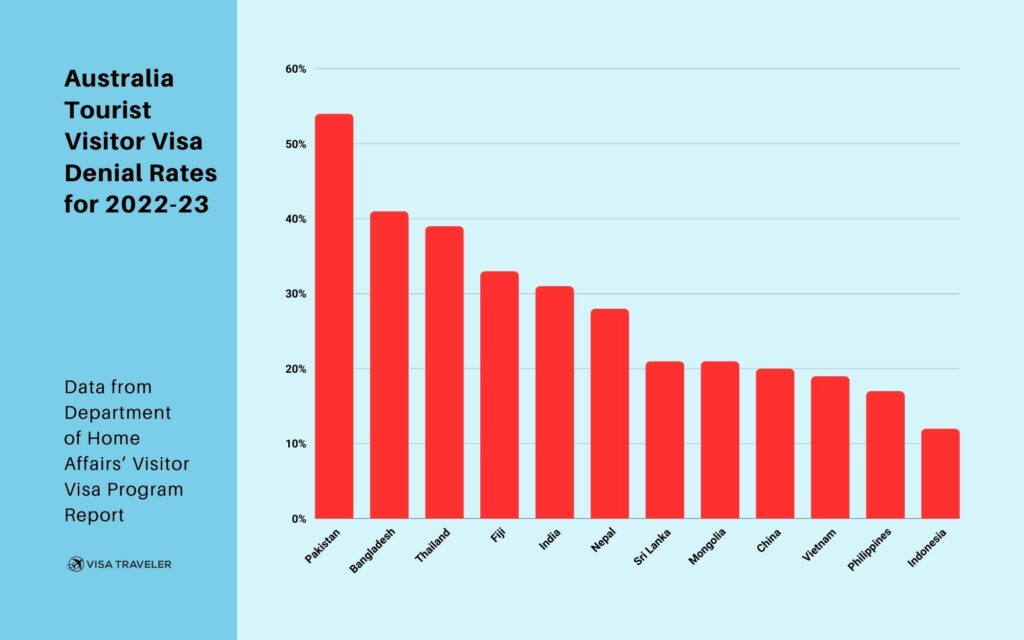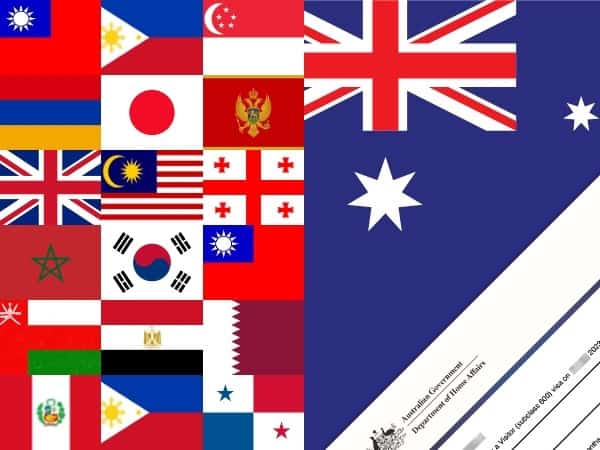
Australia receives over 300,000 applications for visitor visas every month and over 5,000,000 per year. About 15% of all get refused, resulting in almost a million visa refusals yearly. The countries with the highest Australia visa denial rates are Pakistan, Bangladesh, and Thailand at over 40% consistently.
In the overwhelming majority of cases, applicants have failed to convince Home Affairs that they genuinely intend to visit Australia as tourists. This can be due to many reasons, from missing documents to lack of income, no travel history, or no ties to your country.
The burden of proof in regards to being a genuine visitor lies with you, the applicant. In your visa application, you have to supply as many supporting documents as you can and provide sufficient evidence to increase your chances of success.
The top reasons for Australia visa rejection are:
- Insufficient Funds
- Missing Salary Payments
- Lack of Employment
- Short Employment History
- No Illiquid Assets
- No dependant family
- Lack of travel history
- No ties to home country
- Unclear travel plans
Getting a visa rejection is frustrating. It may affect your future applications so if you decide to apply again, it’s all the more important that you build a rock-solid case. Or you must do it right the first time.
***
General reasons why visa applications get refused

Your application will be rejected if you submit an incomplete application form, fake or bogus documents (including an invalid passport) or purposefully conceal or manipulate important information.
The rest of the Australia Visitor Visa requirements are short and vague.
Not meeting either of these is reason enough to have your visa application refused:
- Not meeting the health requirements
- Not meeting the character requirements (substantial criminal record)
- Not having enough money
- Not being a genuine visitor
In practice, the last reason is catchall for most of the rejections that visa applicants receive. Agents of the Home Affairs call it “clause 600.211 in Schedule 2 of the Migration Regulations.”
The rest of the article looks at specific real reasons given for visa rejections. Practically all refused applications that met the health and character requirements were turned down due to clause 600.211, i.e. not proving they were a genuine visitor.
NOTE
The visa refusal reasons in this article are actual reasons given by Australian Immigration in the visa refusal letters. We have put this article together after going through several visa refusal notifications from our readers and on the internet forums.
—
1. Insufficient Funds
“The applicant has demonstrated limited funds which cannot be considered significant.”
You must prove to the Home Affairs that you are well-off financially. If you have a significant source of income in your country, you’re less likely to seek illegal employment in Australia and more likely to return to your country.
The funds you show should be in line with the length of your intended stay. If your itinerary is for a month, show that you have at least 5,000 AUD in your bank account.
Letters of support and guarantees offered by friends/family in Australia are considered by immigration. Still, the bottom line is that you must prove your incentives to depart Australia at the end of your trip.
What you can submit: Bank statements with enough money.
—
2. Missing Salary Payments
“You stated that you earn X monthly salary but the bank statement you submitted does not show such salary payments.”
The personal bank statements you submit should show not only enough savings but also regular incoming payments. You cannot have an unexplained large sum of money deposited into your account and apply for a visa based on that.
What you can submit: Proof of regular income.
—
3. Lack of Employment
“Considering that you are unemployed in your country, you do not have sufficient incentive to leave Australia at the end of your visit.”
Being unemployed can be grounds for a visa rejection because you have no job to return to. Therefore, it’s likely that you will try to find a job in Australia.
What you can submit: Employment contract, letter from employer, and/or approved leave of absence.
—
4. Short Employment History
“The applicant has been employed for less than 12 months.”
Having been in employment for less than 12 months may be reason enough for a visa refusal because of the greater employment and economic opportunities in Australia.
What you can submit: Proof of employment history longer than 1 year.
—
5. Only Liquid Assets in Home Country
“All of the applicant’s assets are liquid and transferable regardless of geographical location”
If you don’t have any property or assets that require you to be in your country to potentially sell, you may be refused a visa. This is because you are not showing any solid ties to your country of origin.
What you can submit: Proof that you own property or any other immovable assets, rental agreement, mortgage, etc.
—
6. No Dependant Family Remaining in Home Country
“The applicant has demonstrated family remaining in their home country but based on the information provided I do not consider these relatives as directly dependent.”
You must show Immigration that you have reasons to return home. If you have no family remaining back home or none depend on you (financially or otherwise), your visa application may be refused.
What you can submit: Bank statements showing financial support of family member(s).
—
7. Lack of Travel History
“There is no evidence that the applicant has any comparable travel outside his region.”
The applicant in question is from Pakistan and has a travel history to other Asian countries only. If you’ve traveled to the Schengen Area, UK, USA, or Canada, you have much better chances with your Australia visa application.
What you can submit: previous flight tickets, boarding passes, bookings, entry/exit stamps in passport, used visas from developed countries.
—
8. No Ties to Home Country
“The applicant has not demonstrated any strong financial or other ties to his country.”
Anything goes here. There isn’t an official list of acceptable ties to avoid an Australian visitor visa refusal but these 4 general ones help:
- Job
- Home
- Family
- Assets
What you can submit: Employment contract or university proof of enrolment, family register, and/or property deed.
—
9. Unclear Plans
“The applicant’s plans during his stay in Australia are unclear.”
Your Australia visa denial is certain if you don’t explain where you will be going. Have a detailed itinerary with specific dates and the places you want to visit.
What you can submit: Travel itinerary, flight tickets, tickets for any event or attraction, invitations to weddings, birthdays, or special events in Australia.
***
Should you appeal or apply again?
If you believe that your visa application was refused incorrectly or unreasonably, then you can appeal with the Administrative Appeals Tribunal (AAT) of Australia.
It is a lengthy process. For Visitor Visa appeals, the processing time is often more than 1 year. It is also quite costly: lodging an appeal costs 3,374 AUD with only half refunded if the case is decided in your favor.
It doesn’t make sense to appeal a tourism visa rejection. Instead, gather more documents and submit a new, stronger visa application.
***
Frequently Asked Questions (FAQs)
What is the denial rate for Australian visas?
As per Department of Home Affairs’ Visitor Visa Program Report for 2022-23 (01 Jul 2022 to 30 Jun 2023), the following are the denial rates for Australian visas.
- For the ETA, the denial rate is 2.2%.
- For the eVisitor, the denial rate is 1.1%.
- For the Tourist Visitor visa (not sponsored), the denial rate is 24.2%.
- For the Tourist Visitor visa (sponsored), the denial rate is 29%.
Can I appeal if my Australian visa is rejected?
Yes, you can appeal with the Administrative Appeals Tribunal (AAT) but considering how costly and long the procedure is, it is not recommended in the overwhelming majority of cases.
Is it possible to get an Australian visa after refusal?
Yes! It is possible to get an Australian visa after refusal. Read through the refusal notification and make a note of the reasons why your visa application was refused. Pay attention to the exact reasons why the immigration officer was not convinced that you are a genuine visitor.
Gather all the evidence to support your case. Reapply with the new evidence and you will have a high chance of getting your visa approved.
How long after an Australia visa refusal can I reapply?
There is no minimum time between a visa refusal and a new visa application.
However, if nothing substantial has changed in your circumstances and you don’t submit any additional documents, the result will be the same.

 Australian Bridging Visas: An Essential Guide
Australian Bridging Visas: An Essential Guide Australia Visa Extension: How to Extend Your Stay in Australia
Australia Visa Extension: How to Extend Your Stay in Australia 18 VISA-FREE Countries You Can Visit with Australian Visa or PR [2024 Edition]
18 VISA-FREE Countries You Can Visit with Australian Visa or PR [2024 Edition]
Leave a Reply